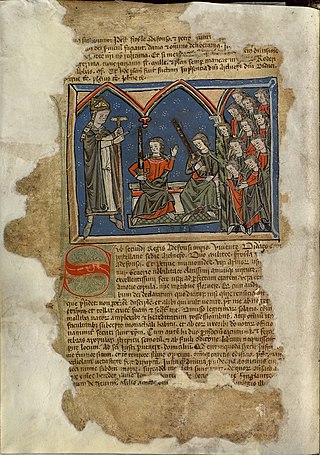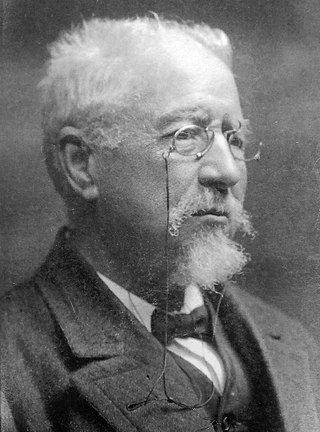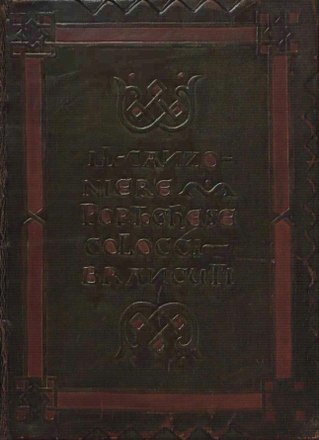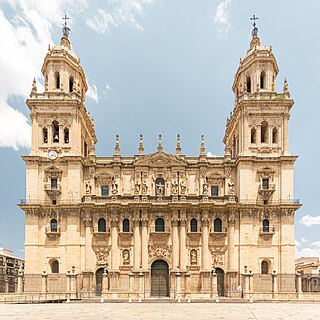The Historia Compostelana is a historical chronicle by several authors based on the relation of events by a writer in the immediate circle of Diego Gelmírez, second bishop (1100–1120) then first archbishop (1120–1140) of Compostela, one of the major figures of the Middle Ages in Galicia. The primary narrative of the Historia Compostelana spans the years 1100 – 1139, the years of Gelmírez' tenure, in three books. Its twofold central agenda is to extol the Archbishop's doings, while establishing the foundation and rights of Santiago de Compostela, including its founding legend, which provided apostolic connections with Saint James the Great. The bishopric had been transferred from Iria Flavia to Compostela as recently as 1095.

Diego Gelmírez or Xelmírez was the second bishop and first archbishop of the Catholic Archdiocese of Santiago de Compostela in Galicia, modern Spain. He is a prominent figure in the history of Galicia and an important historiographer of the Iberia of his day. Diego involved himself in many quarrels, ecclesiastical and secular, which were recounted in the Historia Compostelana, which covered his episcopacy from 1100 to 1139 and serves as a sort of gesta of the bishop's life.

Manuel Antonio Martínez Murguía was a Galician journalist and historian who created the Real Academia Galega. He was one of the main figures in Galician Rexurdimento movement. He is also remembered as Rosalía de Castro's husband, publisher and main supporter.

The Battle of Clavijo is a mythical battle, believed for centuries to be historical, which became a popular theme of Spanish traditions regarding the Christian expulsion of the Muslims. Stories about the battle first arose centuries after it allegedly occurred; according to these stories, it was fought near Clavijo between Christians led by Ramiro I of Asturias and Muslims led by the Emir of Córdoba.The Diccionario de historia de España (1968) says: "To a serious historian, the existence of the Battle of Clavijo is not even a topic of discussion."

The Cancioneiro da Biblioteca Nacional, commonly called Colocci-Brancuti, is a compilation of Galician-Portuguese lyrics by both troubadours and jograes. These cantigas (songs) are classified, following indications in the poems themselves and in the manuscript tradition, into three main genres: cantigas de amigo, cantigas de amor and cantigas de escárnio e mal-dizer.
Olivares is a city located in the Province of Seville, Spain. According to the 2016 census (INE), the city has a population of 9480 inhabitants. It is located in the Aljarafe, the comarca downstream of the Guadalquivir and west of Seville. It borders Albaida to the west, Gerena to the north, Salteras to the east, and Sanlúcar la Mayor and Villanueva del Ariscal to the south. After the establishment of the House of Olivares, it grew in size and influence, becoming an important urban center in the Aljarafe.

The Assumption of the Virgin Cathedral is a Renaissance-style, Roman Catholic cathedral located in Santa María Square, opposite the Town Hall and the Episcopal Palace, in the center of Jaén, region of Andalusia, Spain.

Pedro Fróilaz de Traba was the most powerful secular magnate in the Kingdom of Galicia during the first quarter of the twelfth century. According to the Historia compostelana, he was "spirited ... warlike ... of great power ... a man who feared God and hated iniquity," for Diego Gelmírez himself had "fed him, like a spiritual son, with the nutriment of holy teaching." Brought up at the court of the Emperor Alfonso VI, Pedro raised the future Emperor Alfonso VII in his household. Around the latter he and Diego formed a "Galician party" that dominated that region during the turbulent reign of Urraca (1109–26). In September 1111 they even had the child Alfonso crowned king at Santiago de Compostela, but it was Pedro who was imperator in orbe Galletiae.

The Cathedral of Málaga is a Roman Catholic church in the city of Málaga in Andalusia in southern Spain. It is in the Renaissance architectural tradition. The cathedral is located within the limits defined by a now missing portion of the medieval Moorish walls, the remains of which surround the nearby Alcazaba and the Castle of Gibralfaro. It was constructed between 1528 and 1782, following the plans drawn by Diego de Siloe; its interior is also in Renaissance style.

Saint Mary's Cathedral, better known as Lugo Cathedral, is a Roman Catholic church and basilica in Lugo, Galicia, north-western Spain. The cathedral was erected in the early 12th century in a Romanesque style, with Gothic, Baroque and Neoclassical elements.
Turonio was the only part of the Conventus Bracarensis which did not join Afonso Henriques when he proclaimed the independence of Portugal in 1139. At the time it was a fief held by Gómez Núñez, who supported a Portuguese invasion of Galicia, but was defeated and exiled by Alfonso VII of León.

John of Castile, called the "el de Tarifa" was an infante of Castile and León. He was engaged in a decades-long fight for control over the Lordship of Biscay with Diego López V de Haro, the uncle of his wife.

The Former Cathedral of Idanha-a-Velha is the decommissioned medieval Catholic cathedral of the former bishopric of Egitânia, in the Freguesia of Monsanto e Idanha-a-Velha, in the municipality of Idanha-a-Nova, in the central Portuguese district of Castelo Branco.
The following is a timeline of the history of the city of Camagüey, Cuba.
The following is a timeline of the history of the city of Salamanca, Spain.

Caralho is a vulgar Portuguese-language word with a variety of meanings and uses. Literally, it is a noun referring to the penis, similar to English dick, but it is also used as an interjection expressing surprise, admiration, or dismay in both negative and positive senses in the same way as fuck in English. Caralho is also used in the intensifiers para caralho, placed after adjectives and sometimes adverbs and nouns to mean "very much" or "lots of", and do caralho, both of which are equivalent to the English vulgarities fucking and as fuck.

Elías Tormo y Monzó (1869–1957) was a Spanish art historian.
El final del camino is an adventure television series set in 11th-and 12th-century Iberia, with the construction of the Santiago de Compostela Cathedral as backdrop. It aired in 2017 on La 1 and TVG.
Roberto Castrovido Sanz was a Spanish journalist and politician who served as legislator in the Congress of Deputies a number of times during the Restoration period between 1912 and 1920, and again during the Second Spanish Republic between 1931 and 1933.













